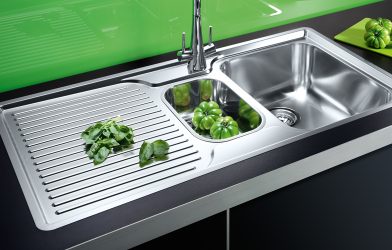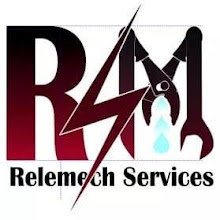Every kitchen needs a sink and faucet but when it comes to selecting these staples, style is secondary. You should select a sink and faucet that will work well and withstand years of daily use. To that end, the most important factor to consider is how you are going to use your kitchen sink, this goes a long way to help a consultant or supplier on which sink to recommend. Within the vast realm of sink choices there are 3 basic differentiators that you'll want to become familiar with;
1.Material - what the sink is made out of2.Installation type - how it's installed and fixed into the countertop
3.Configuration/size - single or multi-bowl, overall size
MATERIAL OF SINK
1.Stainless Steel
Stainless steel in its simplest terms is steel that has been alloyed or "combined with" other elements that give it more beneficial properties than it would otherwise have on its own.Stainless steel sinks have many advantages and possess qualities that make them a good choice for any environment.
Affordability - They are relatively cheap compared to other materials ecxept for the high end options
Improved - They continue to be upgraded with 16 and 18 gauge, which are thicker and less noisy compared to there predecessor, available for you choosing
Durable - Stainless is perfect for sinks and other applications as it wont chip, fade, crack or strain.
Bowl capacity – Stainless steels relatively light yet strong properties allow it to be formed into larger and deeper bowls that might not otherwise be feasible with cast iron or other materials.
Easy to take care of – Stainless steel is easy to take care of and unaffected by
household chemicals as it retains the original luster when cleaned with household cleanser and soft towel. These are just but a few of the many advantages of this kind of a material for a kitchen sink.
Easy to take care of – Stainless steel is easy to take care of and unaffected by
household chemicals as it retains the original luster when cleaned with household cleanser and soft towel. These are just but a few of the many advantages of this kind of a material for a kitchen sink.
2. Composite Granite
A composite granite sink is made using a mix of granite stone dust and acrylic resins molded into sink form. This combination produces a material that has many of the same aesthetic qualities of real granite or quartz without the maintenance and durability issues associated with those types of sinks. |
| A Composite Granite Sink |
These types of sinks also comes with the following advantages:
Durabilty - They withstand dents and scratches typically resulting from daily use. Granite composite sinks also resist damage from strong cleaners and detergents that usually stain sinks composed of other materials, like quartz composite.
Heat Resistant - These types of sinks can withstand high temperatures of up to 279degrees. They do not crack or lose colour when exposed to high temperatures.
Variety - There are several varieties available for your choosing in different styles, bowl capacity,shapes, finishes options.
3. Porcelain or enamel over cast iron:
3. Porcelain or enamel over cast iron:
Porcelain or enamel over a cast-iron sink is a popular material for kitchen sinks. Not only are they heavy and durable, these kitchen sinks can also be very stylish, since they are manufactured in a very wide range of shapes and colors. They are resistant to hot or cold objects, just like stainless steel; however, porcelain can be damaged by sharp impacts. Cleaning aggressively will dull the surface, leading to more dirt accumulation. Enamel-over-cast iron is similar to the porcelain, but these sinks are a less rugged and less expensive alternative. Easy-to-clean enameled cast-iron sinks do provide the most color choices and a hard finish.
 |
| Porcelain overcast iron sink |
Copper sinks are usually made of hammered copper, which gives them a very old-fashioned feel. Copper sinks come in a number of shades and are usually sealed to prevent corrosion. Without sealing, copper requires periodic polishing and can be protected with wax.
Glass:
Glass:
Glass is a common material for vessel sinks. A glass sink can contain a beautiful array of colors, and it catches the light when water runs through it. Tempered glass is also very durable, easy to clean and won't stain.
INSTALLATION TYPE
1.Self-rimming/Drop-in Sinks
These are the easiest types of sinks to instll as they simply fit into a cutout in the countertop on top of a base cabinet, supported by the flanges of the sink that overlap the cutout.INSTALLATION TYPE
1.Self-rimming/Drop-in Sinks
Self-rimming sinks have rounded corners;they are mounted on the countertop. There are several advantages to this type of installation.
They are easiest to install
You only need plumber's putty for the drains and seals on the pipes as you simply drop a self-rimming sink into place, then connect the plumbing.
Simple design means fewer leaks
The simple design of most self-rimming sinks means that they pose fewer problems with leaks. Because self-rimming sinks are usually made from single-piece molded designs, there are very few seams where a leak could sprout.
The simple design of most self-rimming sinks means that they pose fewer problems with leaks. Because self-rimming sinks are usually made from single-piece molded designs, there are very few seams where a leak could sprout.
They are easy to Replace
Just as they are the kitchen sink to install, self-rimming sinks are also the easiest to replace. Replacing a self-rimming sink is as simple as disconnecting the plumbing, lifting the old sink from the countertop, and installing a new unit.
They match Most Countertops
Self-rimming sinks are an excellent choice for mixing and matching with countertop materials and backsplash elements. Most self-rimming sinks are made of stainless steel, which looks great in any space.
Self-rimming sinks are an excellent choice for mixing and matching with countertop materials and backsplash elements. Most self-rimming sinks are made of stainless steel, which looks great in any space.
Less Expensive
Self-rimming sinks are much less expensive than other types of sinks. They are often produced using steel injections methods that them to be produced efficiently. The popularity of these sinks also means that manufacturers offer competitive pricing.
2. Undermount
Undermount sinks are attached under the countertop. They either hang from the underside of the countertop or are supported from underneath by the base cabinet structure.
Advantages of an Undermount Sink
- Adds aesthetic value to a home
- Add more functionality to the kitchen sink
- Can be easier to clean and maintain depending on style
- Food and debris from the counter will not get stuck under the lip since none is present
- Sinks can have a minimalistic or luxurious style
- Food can be slid from the counter to the sink without causing an additional mess
- Multiple colors, styles and material types are available
3.Flush Mount
Flush mount sinks are similar to self-rimming sinks except flush mount sinks are only used with tile countertops. The tile is installed flush with the mounting flange of the sink resulting in a flush surface with the countertop. A grout line between the edge of the sink and the tile completes the installation. However, because there countertop is tile, grout lines are ever present, thus the sink appears to sit flush. Flush mount sinks have advantages and disadvantages similar to both drop-in sinks and undermount sinks.
CONFIGURATION/SIZE
Today’s options for sink type include variations in shape, configuration, and size. All these options become important because each directly affects usability and appeal. The task for most sink shoppers is to balance looks and utility.
CONFIGURATION/SIZE
Today’s options for sink type include variations in shape, configuration, and size. All these options become important because each directly affects usability and appeal. The task for most sink shoppers is to balance looks and utility.
 |
| Square corner Sink |
Modern sinks come in all shapes; Square corners provide the most space inside the sink. Sharp ninety-degree angles make sure no volume is lost in the sink’s shape. You should note that some consumers express dissatisfaction with square corners because it is difficult to get all the water out of the sink when you are done using it. The problem of standing water in the sink is worsened when the sink is stainless steel and/or you have hard water in your area. The mineral deposits will build over time and potentially leave your sink with unappealing water spots.
Rounded corners has grown in popularity because they reduce the problem of standing water in the sink. However, the rounded corners reduce the volume of the sink. Most consumers do not notice this issue unless their sink is quite small or shallow.
Configuration refers to the overall appearance of the sink including the location of drain and faucet holes, number of bowls, and proportions of bowls. Innovations in sink design provide interesting options in unexpected areas. While a center drain is still the most common, some designs are moving the drain to a side to allow for more space under the sink (think about how much room you create by moving the piping to one of the back corners). Faucet holes are less about sink design and more about the type of faucet you install. The only decision most sink buyers have to make is whether the want extra holes for soap dispensers and/or filtered water systems. The faucet hole conversation is only important for drop-in sinks, as undermount sinks are not connected to the faucet mounting area but the decision still impacts countertop installation.
Rounded corners has grown in popularity because they reduce the problem of standing water in the sink. However, the rounded corners reduce the volume of the sink. Most consumers do not notice this issue unless their sink is quite small or shallow.
Configuration refers to the overall appearance of the sink including the location of drain and faucet holes, number of bowls, and proportions of bowls. Innovations in sink design provide interesting options in unexpected areas. While a center drain is still the most common, some designs are moving the drain to a side to allow for more space under the sink (think about how much room you create by moving the piping to one of the back corners). Faucet holes are less about sink design and more about the type of faucet you install. The only decision most sink buyers have to make is whether the want extra holes for soap dispensers and/or filtered water systems. The faucet hole conversation is only important for drop-in sinks, as undermount sinks are not connected to the faucet mounting area but the decision still impacts countertop installation.
 |
| Double Bowl Kitchen Sink |
Preference and logistics play a role in deciding how many bowls to include in your sink design. If your kitchen is small, there might only be room for a single bowl. Putting two very small bowls in a limited space often results in frustration for the user because nothing fits in either sink. Larger kitchens can accommodate any number of bowls so user preference trumps. The traditional layout of two equal sized sinks is still a staple in the industry, but remodelers are pressing the boundaries in this regard by varying the dimensions of the sinks in many ways. At the end of the day, imagination has no bounds with regard to configuration and size of sink in modern kitchen design.
We hope this article was of great value and you are able to purchase a kitchen sink without fear of getting something contrary to your taste and needs. Kindly share your thoughts with us by posting, commenting or Email. Read, Learn and Share.
















